CADILLAC STS 2011 1.G Repair Manual
Manufacturer: CADILLAC, Model Year: 2011, Model line: STS, Model: CADILLAC STS 2011 1.GPages: 528, PDF Size: 4.96 MB
Page 61 of 528
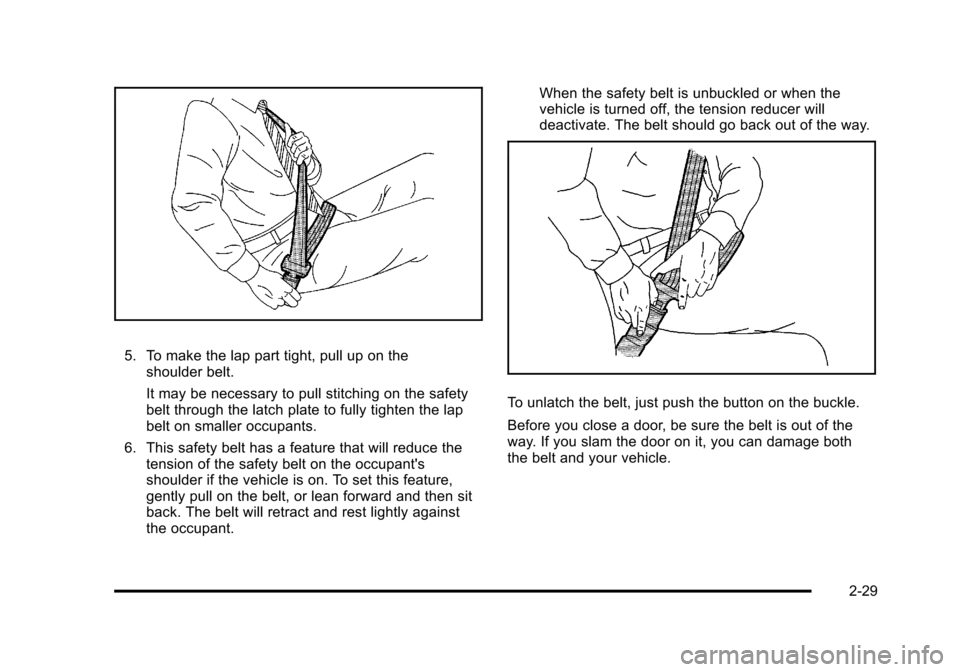
Black plate (29,1)Cadillac STS Owner Manual - 2011
5. To make the lap part tight, pull up on theshoulder belt.
It may be necessary to pull stitching on the safety
belt through the latch plate to fully tighten the lap
belt on smaller occupants.
6. This safety belt has a feature that will reduce the tension of the safety belt on the occupant's
shoulder if the vehicle is on. To set this feature,
gently pull on the belt, or lean forward and then sit
back. The belt will retract and rest lightly against
the occupant. When the safety belt is unbuckled or when the
vehicle is turned off, the tension reducer will
deactivate. The belt should go back out of the way.
To unlatch the belt, just push the button on the buckle.
Before you close a door, be sure the belt is out of the
way. If you slam the door on it, you can damage both
the belt and your vehicle.
2-29
Page 62 of 528
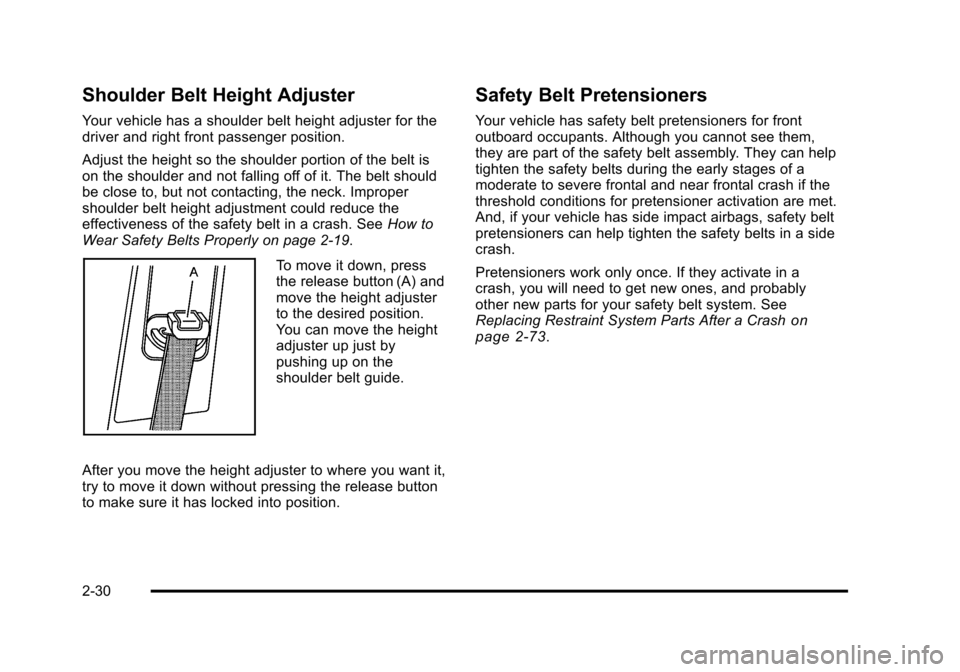
Black plate (30,1)Cadillac STS Owner Manual - 2011
Shoulder Belt Height Adjuster
Your vehicle has a shoulder belt height adjuster for the
driver and right front passenger position.
Adjust the height so the shoulder portion of the belt is
on the shoulder and not falling off of it. The belt should
be close to, but not contacting, the neck. Improper
shoulder belt height adjustment could reduce the
effectiveness of the safety belt in a crash. SeeHow to
Wear Safety Belts Properly on page 2‑19.
To move it down, press
the release button (A) and
move the height adjuster
to the desired position.
You can move the height
adjuster up just by
pushing up on the
shoulder belt guide.
After you move the height adjuster to where you want it,
try to move it down without pressing the release button
to make sure it has locked into position.
Safety Belt Pretensioners
Your vehicle has safety belt pretensioners for front
outboard occupants. Although you cannot see them,
they are part of the safety belt assembly. They can help
tighten the safety belts during the early stages of a
moderate to severe frontal and near frontal crash if the
threshold conditions for pretensioner activation are met.
And, if your vehicle has side impact airbags, safety belt
pretensioners can help tighten the safety belts in a side
crash.
Pretensioners work only once. If they activate in a
crash, you will need to get new ones, and probably
other new parts for your safety belt system. See
Replacing Restraint System Parts After a Crash
on
page 2‑73.
2-30
Page 63 of 528
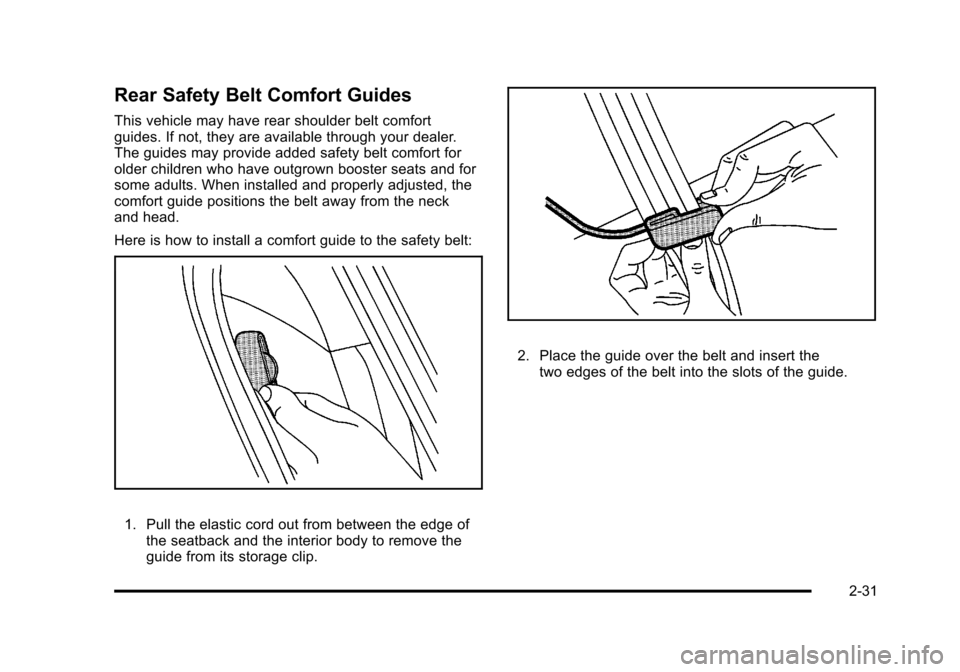
Black plate (31,1)Cadillac STS Owner Manual - 2011
Rear Safety Belt Comfort Guides
This vehicle may have rear shoulder belt comfort
guides. If not, they are available through your dealer.
The guides may provide added safety belt comfort for
older children who have outgrown booster seats and for
some adults. When installed and properly adjusted, the
comfort guide positions the belt away from the neck
and head.
Here is how to install a comfort guide to the safety belt:
1. Pull the elastic cord out from between the edge ofthe seatback and the interior body to remove the
guide from its storage clip.
2. Place the guide over the belt and insert thetwo edges of the belt into the slots of the guide.
2-31
Page 64 of 528
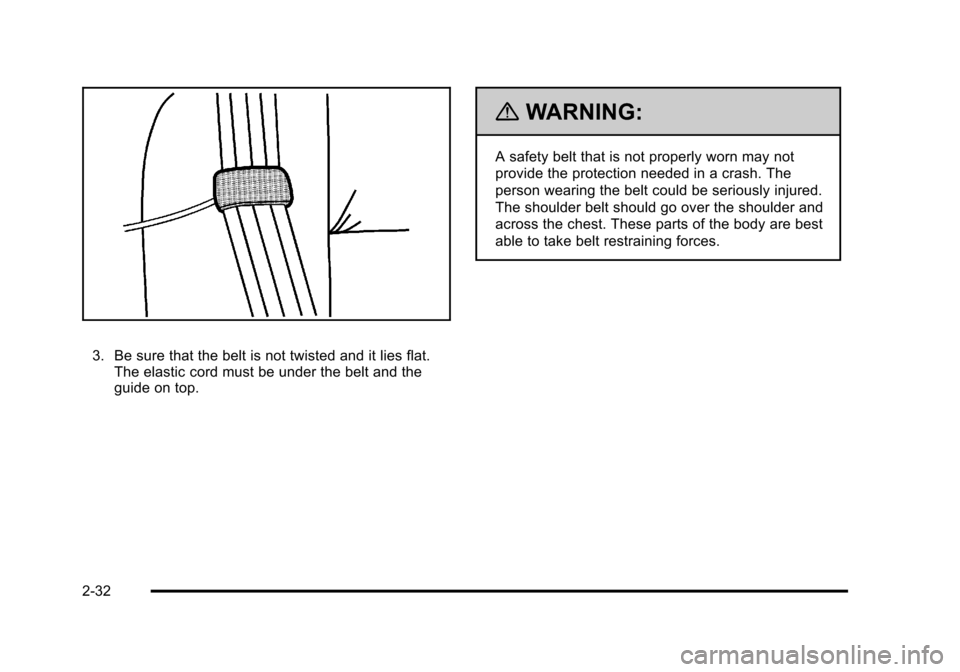
Black plate (32,1)Cadillac STS Owner Manual - 2011
3. Be sure that the belt is not twisted and it lies flat.The elastic cord must be under the belt and the
guide on top.
{WARNING:
A safety belt that is not properly worn may not
provide the protection needed in a crash. The
person wearing the belt could be seriously injured.
The shoulder belt should go over the shoulder and
across the chest. These parts of the body are best
able to take belt restraining forces.
2-32
Page 65 of 528
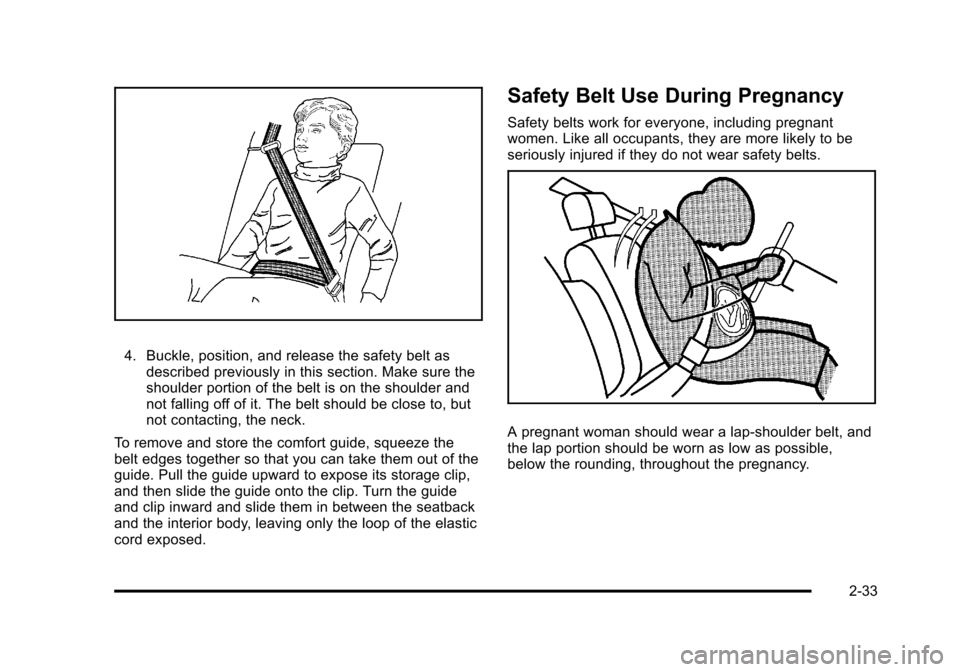
Black plate (33,1)Cadillac STS Owner Manual - 2011
4. Buckle, position, and release the safety belt asdescribed previously in this section. Make sure the
shoulder portion of the belt is on the shoulder and
not falling off of it. The belt should be close to, but
not contacting, the neck.
To remove and store the comfort guide, squeeze the
belt edges together so that you can take them out of the
guide. Pull the guide upward to expose its storage clip,
and then slide the guide onto the clip. Turn the guide
and clip inward and slide them in between the seatback
and the interior body, leaving only the loop of the elastic
cord exposed.
Safety Belt Use During Pregnancy
Safety belts work for everyone, including pregnant
women. Like all occupants, they are more likely to be
seriously injured if they do not wear safety belts.
A pregnant woman should wear a lap-shoulder belt, and
the lap portion should be worn as low as possible,
below the rounding, throughout the pregnancy.
2-33
Page 66 of 528
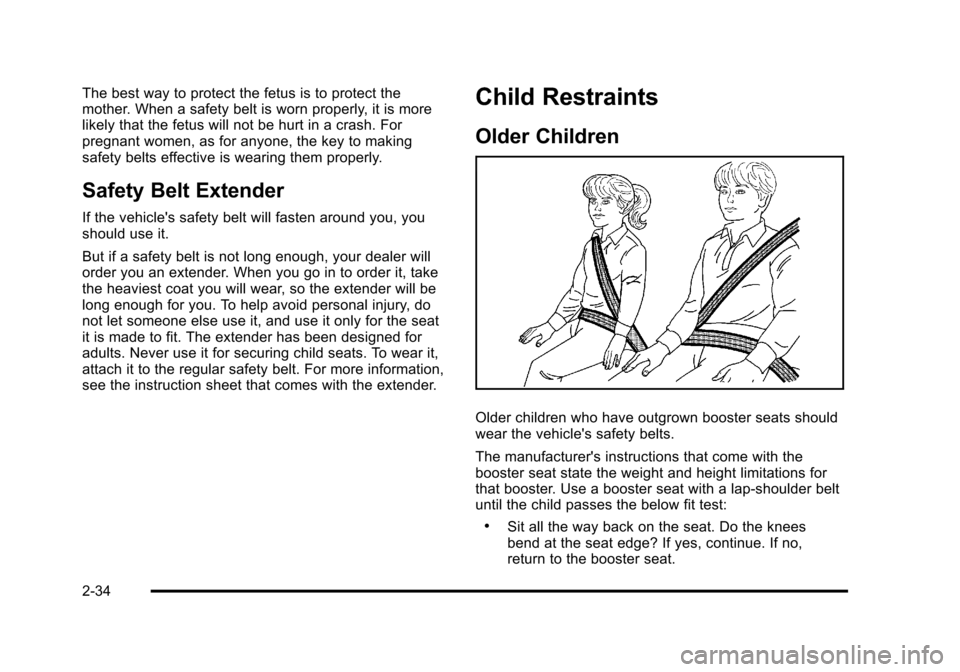
Black plate (34,1)Cadillac STS Owner Manual - 2011
The best way to protect the fetus is to protect the
mother. When a safety belt is worn properly, it is more
likely that the fetus will not be hurt in a crash. For
pregnant women, as for anyone, the key to making
safety belts effective is wearing them properly.
Safety Belt Extender
If the vehicle's safety belt will fasten around you, you
should use it.
But if a safety belt is not long enough, your dealer will
order you an extender. When you go in to order it, take
the heaviest coat you will wear, so the extender will be
long enough for you. To help avoid personal injury, do
not let someone else use it, and use it only for the seat
it is made to fit. The extender has been designed for
adults. Never use it for securing child seats. To wear it,
attach it to the regular safety belt. For more information,
see the instruction sheet that comes with the extender.
Child Restraints
Older Children
Older children who have outgrown booster seats should
wear the vehicle's safety belts.
The manufacturer's instructions that come with the
booster seat state the weight and height limitations for
that booster. Use a booster seat with a lap-shoulder belt
until the child passes the below fit test:
.Sit all the way back on the seat. Do the knees
bend at the seat edge? If yes, continue. If no,
return to the booster seat.
2-34
Page 67 of 528
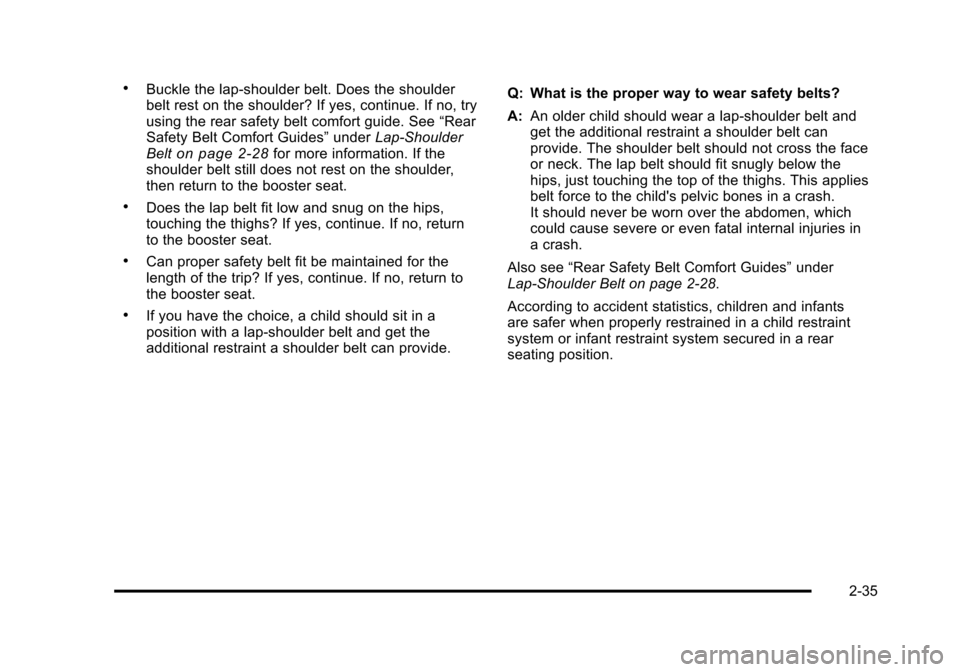
Black plate (35,1)Cadillac STS Owner Manual - 2011
.Buckle the lap-shoulder belt. Does the shoulder
belt rest on the shoulder? If yes, continue. If no, try
using the rear safety belt comfort guide. See“Rear
Safety Belt Comfort Guides” underLap-Shoulder
Belt
on page 2‑28for more information. If the
shoulder belt still does not rest on the shoulder,
then return to the booster seat.
.Does the lap belt fit low and snug on the hips,
touching the thighs? If yes, continue. If no, return
to the booster seat.
.Can proper safety belt fit be maintained for the
length of the trip? If yes, continue. If no, return to
the booster seat.
.If you have the choice, a child should sit in a
position with a lap-shoulder belt and get the
additional restraint a shoulder belt can provide. Q: What is the proper way to wear safety belts?
A:
An older child should wear a lap-shoulder belt and
get the additional restraint a shoulder belt can
provide. The shoulder belt should not cross the face
or neck. The lap belt should fit snugly below the
hips, just touching the top of the thighs. This applies
belt force to the child's pelvic bones in a crash.
It should never be worn over the abdomen, which
could cause severe or even fatal internal injuries in
a crash.
Also see “Rear Safety Belt Comfort Guides” under
Lap-Shoulder Belt on page 2‑28.
According to accident statistics, children and infants
are safer when properly restrained in a child restraint
system or infant restraint system secured in a rear
seating position.
2-35
Page 68 of 528
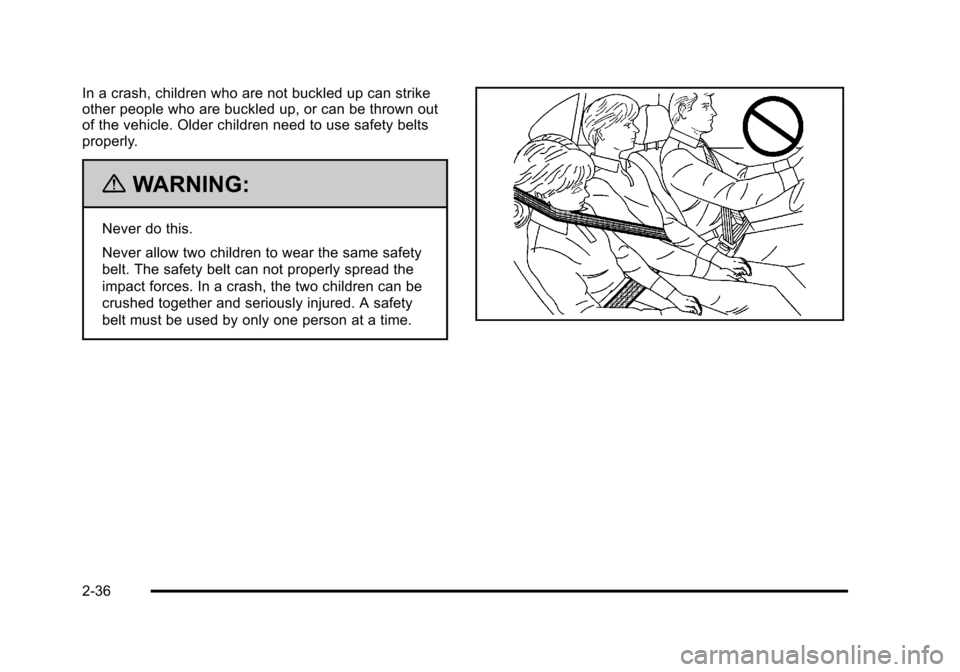
Black plate (36,1)Cadillac STS Owner Manual - 2011
In a crash, children who are not buckled up can strike
other people who are buckled up, or can be thrown out
of the vehicle. Older children need to use safety belts
properly.
{WARNING:
Never do this.
Never allow two children to wear the same safety
belt. The safety belt can not properly spread the
impact forces. In a crash, the two children can be
crushed together and seriously injured. A safety
belt must be used by only one person at a time.
2-36
Page 69 of 528
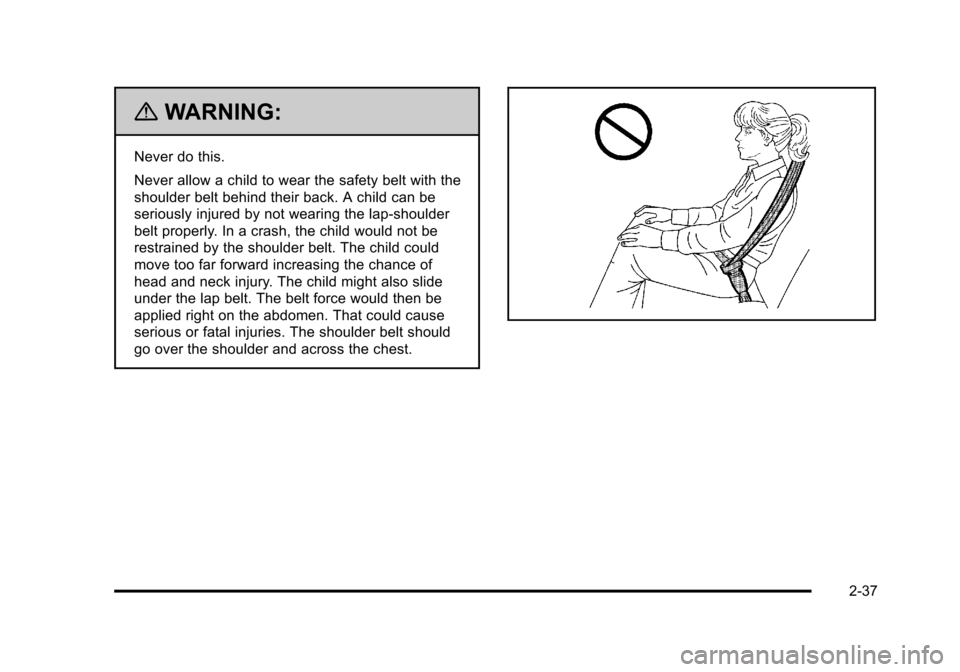
Black plate (37,1)Cadillac STS Owner Manual - 2011
{WARNING:
Never do this.
Never allow a child to wear the safety belt with the
shoulder belt behind their back. A child can be
seriously injured by not wearing the lap-shoulder
belt properly. In a crash, the child would not be
restrained by the shoulder belt. The child could
move too far forward increasing the chance of
head and neck injury. The child might also slide
under the lap belt. The belt force would then be
applied right on the abdomen. That could cause
serious or fatal injuries. The shoulder belt should
go over the shoulder and across the chest.
2-37
Page 70 of 528
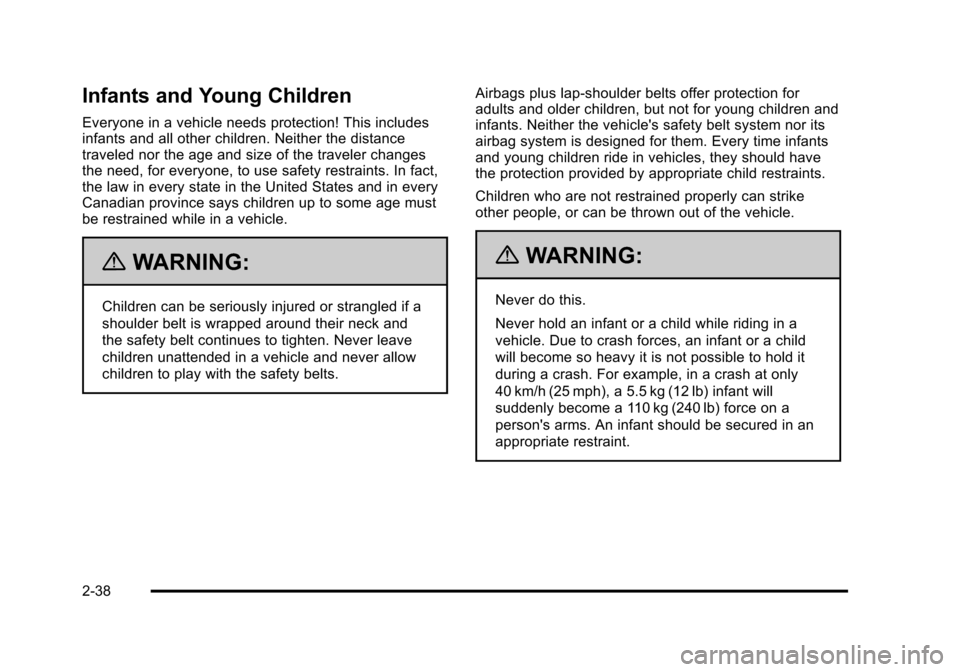
Black plate (38,1)Cadillac STS Owner Manual - 2011
Infants and Young Children
Everyone in a vehicle needs protection! This includes
infants and all other children. Neither the distance
traveled nor the age and size of the traveler changes
the need, for everyone, to use safety restraints. In fact,
the law in every state in the United States and in every
Canadian province says children up to some age must
be restrained while in a vehicle.
{WARNING:
Children can be seriously injured or strangled if a
shoulder belt is wrapped around their neck and
the safety belt continues to tighten. Never leave
children unattended in a vehicle and never allow
children to play with the safety belts.Airbags plus lap‐shoulder belts offer protection for
adults and older children, but not for young children and
infants. Neither the vehicle's safety belt system nor its
airbag system is designed for them. Every time infants
and young children ride in vehicles, they should have
the protection provided by appropriate child restraints.
Children who are not restrained properly can strike
other people, or can be thrown out of the vehicle.
{WARNING:
Never do this.
Never hold an infant or a child while riding in a
vehicle. Due to crash forces, an infant or a child
will become so heavy it is not possible to hold it
during a crash. For example, in a crash at only
40 km/h (25 mph), a 5.5 kg (12 lb) infant will
suddenly become a 110 kg (240 lb) force on a
person's arms. An infant should be secured in an
appropriate restraint.
2-38